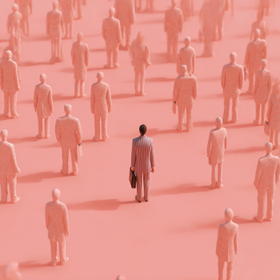D Eye-tracking in UX Research
Por Redacción Aguayo
Learn all about eye-tracking in UX research. Discover its applications, methods, benefits and more.

Introduction to Eye-tracking
What is Eye-tracking?
Eye-tracking is a technology that allows recording and analyzing eye movements. This technique is used to understand how people visually interact with their environment, providing valuable information on which parts of a screen or interface capture the most attention, how the eyes move from one point to another, and which elements might go unnoticed.
History of Eye-tracking
The concept of eye-tracking is not new. Early studies date back to the late 19th century when researchers like Louis Émile Javal observed eye movements during reading. Over the years, the technology has advanced significantly, evolving from invasive and manual methods to highly sophisticated systems that use cameras and advanced software to record eye movements non-invasively.
In the 1970s, the development of computerized systems allowed for more detailed and precise analysis of eye-tracking data. Today, eye-tracking is used in a wide variety of fields, including psychology, neuroscience, marketing, and, of course, user experience (UX) research.
Importance of Eye-tracking in UX
In the UX field, eye-tracking has become an indispensable tool. It allows designers and researchers to understand how users interact with digital interfaces, providing objective data on visual behavior. This is crucial for identifying areas of improvement in design and ensuring that users can navigate and use an interface efficiently and satisfactorily.
Advantages of Eye-tracking in UX:
- Objective Data: Unlike other research methods that rely on user self-reporting, eye-tracking provides objective and quantifiable data on where and how users look.
- Problem Identification: It allows for the detection of issues in the interface that might not be evident through traditional methods, such as the invisibility of important elements or distractions caused by non-essential elements.
- Usability Improvement: Eye-tracking data can guide designers in creating more intuitive and user-friendly interfaces by optimizing the placement of key elements and improving navigation.
Basic Principles of Eye-tracking
Eye-tracking is a technology that allows recording and analyzing eye movements to understand how people visually interact with their environment. This technology has revolutionized UX research, providing objective and quantifiable data on users' visual behavior. In this chapter, we will delve into the basic principles of eye-tracking, including how it works, its main components, and the different types of devices and methods used in UX research.
How Eye-tracking Works
Eye-tracking is based on detecting and analyzing the position and movement of the eyes. Modern eye-tracking technology typically uses cameras and infrared light sources to illuminate the user's eyes and capture reflections on the cornea and pupil. From these images, eye-tracking software can calculate the direction of gaze and the user's fixation points.
Components of an Eye-tracking System
A typical eye-tracking system consists of the following components:
- Cameras: High-speed cameras capture images of the user's eyes. The resolution and speed of the cameras are crucial for obtaining accurate and detailed data.
- Infrared Illumination: An infrared light source illuminates the user's eyes, creating reflections on the cornea and pupil. This illumination is invisible to the user and does not interfere with their vision.
- Analysis Software: The software processes the captured images to identify reflections and calculate the position and movement of the eyes. From these data, heatmaps, gaze paths, and other visual analyses are generated.
The Eye-tracking Process
The eye-tracking process includes several stages:
- Calibration: Before starting a study, the eye-tracking system must be calibrated for each user. Calibration involves the user looking at specific points on a screen so that the software can adjust its calculations to the user's unique eye characteristics.
- Data Capture: During the user's interaction with the interface, the cameras continuously capture images of the eyes, and the infrared illumination highlights the necessary reflections for analysis.
- Data Analysis: Eye-tracking software processes the captured images to calculate gaze direction and fixation points. These data are used to generate visual representations such as heatmaps and gaze paths.
- Interpretation: Researchers interpret the generated data to gain insights into the user's visual behavior. This includes identifying which areas of the interface attract the most attention, how the user's eyes move, and which elements may go unnoticed.
Types of Eye-tracking Devices
There are several types of eye-tracking devices, each designed for different applications and usage contexts:
1. Screen-mounted Eye-trackers
These devices are placed at the bottom or top of a screen and track eye movements while the user interacts with the interface on that screen. They are common in usability studies and website evaluations due to their ability to provide detailed data on how users interact with specific interface elements.
Advantages:
- High precision in capturing eye movements.
- Ideal for usability studies in controlled environments.
- Allows detailed analysis of interface interaction.
Disadvantages:
- Limited to interaction with a fixed screen.
- May not be suitable for studies in natural environments.
2. Wearable Eye-trackers
These devices, often in the form of glasses, allow eye-tracking in more natural settings and are not limited to a fixed screen. They are useful for field studies and situations where movement freedom is required, such as observing how users interact with physical products in a real environment.
Advantages:
- Allows eye-tracking in natural environments.
- Offers greater movement freedom for the user.
- Ideal for field studies and observing behaviors in real-world situations.
Disadvantages:
- May be less accurate than screen-mounted devices.
- Data analysis complexity can increase due to environmental variability.
3. Integrated Eye-trackers
Some devices, such as smartphones and tablets, are starting to incorporate eye-trackers to enhance interaction and accessibility. These systems allow continuous eye-tracking while the user interacts with the device, providing valuable data for improving the user experience on mobile devices.
Advantages:
- Direct integration into everyday devices.
- Provides real-time data on user interaction.
- Potential to improve accessibility and interface personalization.
Disadvantages:
- Accuracy can be affected by factors such as lighting and viewing angle.
- Limited to specific devices that incorporate the technology.
Applications of Eye-tracking in UX
Eye-tracking has emerged as a powerful and versatile tool in user experience (UX) research. Its ability to provide precise and objective data on how users visually interact with an interface offers valuable insights that can transform the design and optimization of digital products. In this chapter, we will explore in detail the various applications of eye-tracking in UX, ranging from usability testing and interface design to marketing and accessibility.
1. Usability Testing
One of the most common applications of eye-tracking in UX is conducting usability tests. Eye-tracking allows researchers to directly observe how users interact with a website, application, or digital product. By recording eye movements and fixation points, researchers can quickly identify usability issues that might go unnoticed with other methods.
Identifying Usability Issues
Eye-tracking helps identify areas where users may experience confusion or difficulty. For example, if many users spend a lot of time looking at a specific area of the interface without taking any action, it could indicate that the design of that element is not intuitive or not fulfilling its purpose. Heatmaps and gaze paths are visual tools that facilitate this identification.
Optimizing Navigation
Understanding how users navigate through an interface is crucial for optimizing its design. Eye-tracking reveals users' exploration and navigation patterns, allowing designers to adjust the layout and organization of navigation elements to improve efficiency and the overall user experience.
Evaluating Visual Clarity
The visual clarity of an interface is fundamental for a good user experience. Eye-tracking can reveal whether users are perceiving and understanding critical visual elements, such as buttons, links, and calls to action. If users are not fixing their gaze on these elements, it may be necessary to review their design or location.
2. Interface Design
Interface design greatly benefits from eye-tracking by providing data on how users perceive and interact with visual elements. This includes the design of web interfaces as well as mobile applications and other digital products.
A/B Testing
Eye-tracking is particularly useful in A/B testing, where two versions of an interface are compared to determine which is more effective. By analyzing eye-tracking data, designers can see which version better captures users' attention and facilitates more intuitive navigation.
Prototype Evaluation
During the development stages of a product, prototypes can be evaluated using eye-tracking to identify areas for improvement before the final launch. This allows designers to make data-driven adjustments, ensuring that the final product is as intuitive and efficient as possible.
Design of Visual Elements
Visual elements such as images, videos, and graphics must be attractive and easy to understand. Eye-tracking helps designers evaluate how well these elements capture users' attention and communicate the intended message. For example, in banner ad design, eye-tracking can show whether users notice the banner and find it engaging.
3. Marketing and Advertising
Eye-tracking is not only used in design and usability but also serves as a valuable tool in marketing and advertising. It allows marketers to understand how consumers visually interact with ads and other promotional materials.
Ad Evaluation
Ads must quickly capture the viewer's attention and convey a clear message. Eye-tracking allows marketers to evaluate which parts of an ad are attracting attention and whether users understand the message. This can lead to adjustments in ad design to improve its effectiveness.
Content Optimization
Visual content on websites and applications must be optimized to capture and maintain user attention. Eye-tracking can reveal which types of content are most effective at attracting attention and keeping users engaged. This includes images, videos, infographics, and other visual elements.
Packaging Design
The design of packaging for physical products can also benefit from eye-tracking. By analyzing how consumers look at and perceive different packaging designs in a store environment, designers can create packaging that is more attractive and functional.
4. Accessibility
Accessibility is a crucial aspect of UX design that ensures all users, including those with disabilities, can use a product effectively. Eye-tracking provides data that can help improve the accessibility of an interface.
Identifying Accessibility Barriers
Eye-tracking can identify visual barriers that make it difficult for users with visual or cognitive impairments to use an interface. For example, if users with vision problems have trouble locating certain elements, this may indicate the need to improve color contrast or increase font sizes.
Evaluating Assistive Technologies
Assistive technologies, such as screen readers and text magnifiers, can be evaluated using eye-tracking to ensure they are working correctly and helping users. This allows designers to make adjustments and improvements that benefit all users.
5. Research and Development
Eye-tracking is also used in the research and development of new technologies and products. The insights obtained can inform the design and functionality of innovative products.
Developing New Interactions
Eye-tracking can reveal new ways of interacting with technology. For example, in the development of virtual and augmented reality interfaces, understanding how users look at and react to virtual elements is essential for creating immersive and natural experiences.
Human Behavior Research
Beyond UX, eye-tracking is a valuable tool in human behavior research. It can provide data on how people perceive and process visual information, which can have applications in fields such as psychology, neuroscience, and cognitive design.
6. E-commerce
In the realm of e-commerce, eye-tracking can help optimize the online shopping experience, improving conversion rates and customer satisfaction.
Product Page Optimization
Product pages must be clear and attractive to convert visitors into buyers. Eye-tracking can reveal whether users are finding and understanding key product information, such as descriptions, prices, and buy buttons.
Evaluating Shopping Carts
The checkout process should be smooth and frictionless. By analyzing eye-tracking data, designers can identify points where users may be experiencing difficulties or abandoning their shopping carts. This allows for improvements to make the process more streamlined and efficient.
7. Education and Training
In the field of education and training, eye-tracking can be used to improve educational materials and teaching methods.
Evaluating Educational Materials
Eye-tracking can help evaluate the effectiveness of educational materials, such as textbooks, slides, and digital content. By understanding how students interact visually with the material, educators can optimize the design to improve comprehension and retention of information.
Professional Training
In professional training, eye-tracking can be used to analyze how trainees interact with tools and work environments. This can help design more effective training programs tailored to the specific needs of trainees.
The applications of eye-tracking in UX are diverse and span multiple areas, from usability testing and interface design to marketing, accessibility, research, and education. The ability of eye-tracking to provide precise and objective data on users' visual behavior makes it an invaluable tool for enhancing the user experience in a wide range of contexts. As technology continues to advance, we can expect to see even more innovations and applications of eye-tracking in the field of UX.
Methods of Eye-tracking in UX Research
Eye-tracking has become an essential tool in user experience (UX) research due to its ability to provide precise data on how users visually interact with digital interfaces. This chapter will delve deeply into eye-tracking methods in UX research, detailing the various techniques, technologies, and approaches used to collect and analyze eye-tracking data. Additionally, we will discuss the advantages and challenges associated with each method, providing a comprehensive understanding of how eye-tracking can be applied to enhance the design and usability of digital products.
1. Types of Eye-trackers
There are several types of eye-tracking devices, each with its own characteristics and specific applications. The main types of eye-trackers used in UX research include:
Desktop Eye-trackers
Desktop eye-trackers are devices mounted on a computer screen or nearby stand that track the user's eye movements while they interact with a digital interface. These devices are highly accurate and commonly used in laboratory studies.
Portable Eye-trackers
Portable eye-trackers, also known as wearable eye-tracking glasses, are devices that users can wear while interacting with interfaces in real-world environments. These devices allow for greater mobility and flexibility, making it possible to study user behavior in more natural and less controlled situations.
Integrated Eye-trackers
Some modern devices, such as tablets and smartphones, have integrated eye-trackers in their front-facing cameras. Although these devices may not be as accurate as desktop or portable eye-trackers, they offer a convenient way to conduct eye-tracking studies anywhere and anytime.
2. Eye-tracking Techniques
Eye-tracking techniques refer to the specific methods used to track and analyze eye movements. Here are some of the most common techniques:
Fixation Point
The fixation point technique records specific points where the user's gaze stops for a significant period of time. These fixation points provide insights into which visual elements are capturing the user's attention.
Gaze Paths
Gaze paths track the movement of the eyes from one fixation point to another. This technique helps understand the flow of visual attention and how users navigate through an interface.
Heat Maps
Heat maps are visual representations that use colors to indicate areas of the interface where users look most frequently. Warmer colors (like red and yellow) indicate higher visual attention, while cooler colors (like blue and green) indicate less attention.
Fixation Duration
Fixation duration measures the length of each eye fixation. This metric helps understand how much time users spend on each visual element, which can indicate the complexity or interest level of a specific element.
Blinking and Pupil Dilation
Tracking blinks and pupil dilation can provide additional information about the user's emotional and cognitive state. Increased pupil dilation, for example, may indicate higher cognitive effort or interest in visual content.
3. Research Process with Eye-tracking
The research process with eye-tracking in UX follows several key steps, from study planning to data analysis and implementation of improvements. The main steps of this process are described below:
Goal Definition
The first step in any eye-tracking study is to clearly define the research goals. What do you want to learn? What are the specific research questions? Defining these goals will guide the study design and data interpretation.
Participant Selection
Participant selection is crucial to ensure that the results are representative. Participants should be selected based on demographic and behavioral criteria relevant to the product or service in question.
Study Design
Study design includes creating specific tasks that participants must perform while their eye movements are tracked. These tasks should be representative of how users normally interact with the product. Additionally, it should be decided whether the study will be conducted in a controlled laboratory environment or a more natural setting.
Eye-tracker Setup
Eye-tracker setup involves calibrating the device for each individual participant, ensuring that the collected data is accurate and reliable. This involves adjusting the eye-tracker to accurately track the participant's eye movements based on their position and physiological characteristics.
Data Collection
During data collection, participants perform the defined tasks while their eye movements are tracked and recorded. It is important to minimize distractions and ensure that the environment is as natural as possible to obtain representative data.
Data Analysis
Eye-tracking data analysis involves processing and visualizing the collected data to extract meaningful insights. This may include creating heat maps, gaze paths, and fixation time charts. Researchers must interpret this data in the context of the research goals to identify patterns and areas for improvement.
Implementation of Improvements
Finally, insights obtained from eye-tracking studies should be used to make improvements in product design. This may involve redesigning visual elements, reorganizing navigation, or adjusting content to enhance usability and user experience.
4. Advantages of Eye-tracking in UX Research
Using eye-tracking in UX research offers numerous advantages, including:
Objective and Precise Data
Eye-tracking provides objective and precise data on how users visually interact with an interface. This reduces reliance on subjective methods such as surveys and interviews, allowing researchers to base their conclusions on concrete evidence.
Identification of Invisible Problems
Often, usability issues are not apparent through traditional methods. Eye-tracking can reveal problems that are not easily detectable, such as difficulty finding a visual element or confusion caused by button design.
Visual Design Improvement
Eye-tracking helps improve visual design by providing information on which elements capture users' attention and which are ignored. This allows designers to optimize the layout and design of visual elements to enhance user experience.
Understanding User Behavior
Eye-tracking provides deep insights into user behavior by revealing patterns of navigation and visual attention. This is crucial for designing interfaces that are intuitive and easy to use.
5. Challenges and Limitations of Eye-tracking
Despite its many advantages, eye-tracking also presents some challenges and limitations that need to be considered:
Cost and Accessibility
Eye-tracking devices can be expensive, which may limit accessibility for small businesses or independent researchers. Additionally, setting up and maintaining these devices requires specialized technical knowledge.
Data Interpretation
Interpreting eye-tracking data can be complex and requires expertise to avoid misunderstandings. Data should be analyzed in the appropriate context to extract meaningful insights and avoid erroneous conclusions.
Intrusion into Natural Behavior
Knowledge that their eye movements are being tracked can influence participant behavior, affecting the naturalness of the collected data. It is important to design studies that minimize this intrusion and promote as natural behavior as possible.
Individual Variability
Individual variability in eye movements and visual responses can complicate data interpretation. Differences in ocular physiology, previous experience, and other factors can influence results.
Eye-tracking Data Analysis: Extracting Insights After the Study
Eye-tracking data analysis is a crucial phase after conducting a study using this technique. This process involves closely examining the data collected during user interaction with a digital interface to extract meaningful information that can enhance user experience (UX) and user interface (UI).
Extraction of Key Metrics
Once the eye-tracking study is completed and the data is collected, the first step in the analysis is the extraction of key metrics. These metrics may include the duration and frequency of eye fixations in specific areas of the interface, the number of saccadic movements between elements, and the speed of visual exploration.
Identification of Behavioral Patterns
After extracting key metrics, the next step is to identify users' behavioral patterns. This involves analyzing how users interact with the interface, which elements attract their attention the most, and how they move through the page or application.
Comparison between User Groups
In some cases, it may be useful to compare eye-tracking data between different user groups, such as novice users versus experienced users, or users from different demographic groups. This can reveal significant differences in navigation behavior and help design a more inclusive and accessible interface.
Correlation with Other Usability Metrics
Eye-tracking data analysis can be complemented with other usability metrics, such as task completion times or user satisfaction questionnaires. By correlating eye-tracking data with these metrics, it is possible to gain a more comprehensive understanding of the user experience and identify specific areas for improvement.
Generation of Design Recommendations
Finally, based on the insights extracted from eye-tracking data analysis, specific design recommendations can be generated to improve the interface. These recommendations may include changes to the layout of elements, optimization of visual hierarchy, or removal of distractions that may impact the user experience.
Practical Example
For example, when analyzing eye-tracking data from a UX/UI study for an e-commerce website, we might discover that users spend a significant amount of time looking at product images but ignore navigation links at the top of the page. Based on this insight, we could recommend increasing the size of product images and relocating navigation links to enhance usability and conversion.
In conclusion, eye-tracking data analysis is a fundamental step in the UX/UI design process. It provides valuable information about how users interact with a digital interface, allowing for the identification of areas for improvement and optimization of the user experience. By conducting a detailed analysis of eye-tracking data and extracting meaningful insights, designers can create more effective, intuitive, and satisfying interfaces for users.
Best Practices for Eye-tracking Usage
Study Planning
Before conducting an eye-tracking study, careful planning is crucial to ensure the validity and reliability of the results. Some important aspects to consider during planning include:
- Defining Objectives: Clarifying the study's objectives, such as which aspects of the interface will be evaluated and what questions are expected to be answered.
- Participant Selection: Choosing participants who are representative of the product or service's target audience and have the necessary characteristics for the study.
- Experiment Design: Creating a clear and well-structured experimental design that includes specific tasks for participants and consistent test conditions.
- Equipment Choice: Selecting the appropriate eye-tracking equipment for the study's needs, whether hardware or software, considering accuracy and accessibility.
- Study Location: Choosing a suitable study environment that minimizes distractions and provides optimal lighting and comfort conditions for participants.
Data Collection and Analysis
Once the study has been planned and eye-tracking data has been collected, careful analysis is important to extract meaningful insights. Some key considerations during data collection and analysis include:
- Calibration and Validation: Ensuring that the eye-tracking equipment is properly calibrated for each participant and validating the accuracy of the collected data.
- Data Preprocessing: Preprocessing the data to clean and prepare it for analysis, removing artifacts and incorrect or incomplete data.
- Result Interpretation: Systematically and carefully analyzing eye-tracking data to identify significant patterns and trends, and translating these results into specific design recommendations.
- Consideration of Contextual Factors: Taking into account contextual factors, such as usage context and individual participant characteristics, when interpreting study results.
Application in UX/UI Design
Eye-tracking can be an invaluable tool in UX/UI design, providing detailed information on how users interact with a digital interface. Some ways eye-tracking can be applied in design include:
- Optimization of Element Layout: Using eye-tracking data to determine the most effective layout of elements in an interface, such as buttons, menus, and links, to improve usability and accessibility.
- Evaluation of Visual Hierarchy: Analyzing users' gaze patterns to evaluate the effectiveness of an interface's visual hierarchy, ensuring that important elements are prominent and easily identifiable.
- Identification of Problem Areas: Using eye-tracking data to identify problem areas in an interface, such as elements that go unnoticed or confuse users, and making adjustments to enhance the user experience.
- Validation of Iterative Designs: Using eye-tracking to validate iterative designs and assess how changes in the interface affect user behavior, allowing for continuous design improvement.
Conclusions
In summary, effectively using eye-tracking in UX/UI design requires careful planning, rigorous data collection and analysis, and smart application of the insights gained. By following the best practices outlined in this chapter, designers can make the most of eye-tracking's potential to create more effective, intuitive, and satisfying digital interfaces for users.
Conclusions
The Importance of Eye-tracking in UX/UI Design
Eye-tracking has become an invaluable tool for UX/UI designers, providing a detailed understanding of how users interact with digital interfaces. By allowing precise tracking of users' gaze, eye-tracking reveals behavioral patterns that may be difficult to detect through other usability evaluation methods.
Revealing Hidden Insights
One of the main strengths of eye-tracking is its ability to reveal hidden insights about how users actually interact with an interface. Often, users are not aware of where they look or how their eyes move while navigating a website or app. Eye-tracking can uncover gaze patterns that users themselves may not be able to describe, enabling designers to better understand user needs and behaviors.
Validation of Designs and Data-driven Design Decisions
The use of eye-tracking in UX/UI design allows for more robust validation of designs and data-driven design decisions based on concrete data. Instead of relying solely on intuition or subjective user feedback, designers can support their decisions with objective evidence of how users interact with the interface in real time.
Challenges and Limitations
Despite its numerous benefits, eye-tracking also faces challenges and limitations. For example, the cost of eye-tracking equipment may be prohibitive for some projects, and interpreting eye-tracking data may require specialized technical expertise. Additionally, eye-tracking does not provide a comprehensive understanding of the user experience and must be complemented with other usability evaluation methods.
Future Perspectives
The future of eye-tracking in UX/UI design is promising, with technological advances making this technique more accessible and accurate than ever. Developments in the fields of artificial intelligence and machine learning are expected to enable more sophisticated analysis of eye-tracking data, leading to an even deeper understanding of the user experience.
Emerging Applications
In addition to its traditional use in digital interface design, eye-tracking is also being explored in a variety of emerging fields. For example, it is being used in market research to evaluate the effectiveness of advertising and package design, as well as in medicine to study visual and neurological disorders.
Ethical and Privacy Considerations
As eye-tracking becomes more ubiquitous in research and design, it is important to address the ethical and privacy considerations associated with it. Designers should be transparent about the use of eye-tracking and obtain informed consent from study participants. Additionally, measures should be taken to protect the privacy of collected data and ensure that it is used ethically and responsibly.
Final Conclusion
In conclusion, eye-tracking is a powerful tool that has revolutionized the field of UX/UI design, allowing designers to gain a deeper and more accurate understanding of how users interact with digital interfaces. By harnessing the potential of eye-tracking and addressing its challenges and limitations, designers can create more effective, intuitive, and satisfying user experiences in the ever-evolving digital world.


























































































































































































































